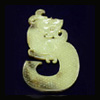- sale
- new items
- lovely beads
- wedding beads
- beads for teens
- for custom order
- newsletter
- recognition
- testimonials
- birthstones
- zodiac signs
- jewelry guide
SHOP BAG
![]() in your bag 0 items
in your bag 0 items

Jade is an ornamental stone, that is applied to two different rocks that are made up of different silicate minerals: nephrite jade and jadeitite. Nephrite can be found in a creamy white form as well as in a variety of green colors, whereas jadeitite shows more color variations, including dazzling blue, lavender-mauve, violet, emerald-green, orange, yellow, pink, brown, and black colors.
The English word "jade" is derived from the Spanish term PIEDRA DE IJADA (first recorded in 1565) or "loin stone", from its reputed efficacy in curing ailments of the loins and kidneys. "Nephrite" is derived from LAPIS NEPHRITICUS, the Latin version of the Spanish PIEDRA DE IJADA.
Nephrite and jadeite were used by people from the prehistoric for similar purposes. Both are about the same hardness as quartz, and they are exceptionally tough. They are beautifully colored and can be delicately shaped. Only in the 19th century it was determined that "jade" was in fact two different materials. Among the earliest known jade artifacts excavated from prehistoric sites are simple ornaments such as rounded beads, buttons, and tubular jades. Additionally, jade was used for axe heads, knives, and other weapons. As metal-working technologies became available, the beauty of jade made it valuable for ornaments and decorative objects.
Of the two, jadeite is rarer, documented in fewer than 12 places worldwide. Translucent emerald-green jadeitite is the most prized variety, both now and historically. As "quetzal" jade, bright green jadeitite from Guatemala was treasured by Mesoamerican cultures, and as "kingfisher" jade, vivid green rocks from Burma became the preferred stone of post-1800 Chinese imperial scholars and rulers. Burma (Myanmar) and Guatemala are the principal sources of modern gem jadeitite, and Canada of modern lapidary nephrite. Nephrite jade was used mostly in pre-1800 China as well as in New Zealand, the Pacific Coast and Atlantic Coasts of North America, Neolithic Europe, and south-east Asia. In addition to Mesoamerica, jadeitite was used by Neolithic Japanese and European cultures.
Jade is the official gemstone of British Columbia, Canada, where it is found in large deposits in the Lillooet and Cassiar regions. It is also the official gemstone of the state of Alaska, found particularly in the Kobuk area. A two ton block of jade sits outside the Anchorage Visitor's Center in downtown Anchorage, Alaska, mined from near Kobuk and donated to the city as a showpiece.


